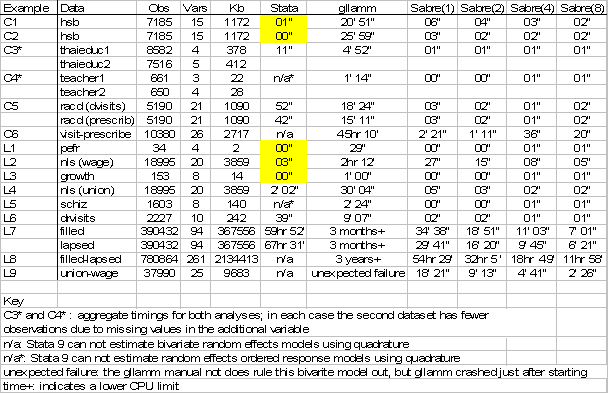
 |
Sabre |
Multilevel Multiprocess
Modelling Examples
The results of the comparison between Stata, gllamm and Sabre (#processors) in terms of CPU time in
hours, minutes(‘) and seconds (“) on 15 example data
sets (C=cross sectional, L=longitudinal) are listed in the table below. Many of
the published data sets in this table are quite small and as such are not very
computationally demanding for Sabre. All the examples, exercises, data sets,
training materials and software may be downloaded from this site
.

All the computations reported
above were performed on
The shaded elements of the Stata
column are for the linear model using the Stata
command xtreg, to estimate a random effects linear
model using MLE. The integrated likelihood for the normal distributed random effects, normal linear model has a closed form. There are
currently no Stata commands for bivariate
random effect models, so no comparison with Stata is
possible, hence the cells with ‘not applicable’ (n/a)
in them. The gllamm timings with a plus sign are from
an estimated lower limit (based on jobs run on a subset of the data), or from
the point where we decided that we could not wait any longer for gllamm to end on its own.
The non-shaded results we quote are for standard quadrature in gllamm. The same number of quadrature points are
used in the Stata, gllamm
and Sabre comparisons. The number of quadrature
points varies by example, depending on the number needed to give a good
approximation to the likelihood. We have not used the gllamm
adaptive quadrature algorithm in these comparisons. The
argument for using adaptive quadrature arises from
the fact that Gaussian
quadrature can perform badly when there are
insufficient locations under the peak of the integrated likelihood. Adaptive quadrature is used to shift the quadrature
points in order to improve the adequacy of the approximation. Adaptive quadrature generally requires fewer quadrature
points than standard quadrature to provide the same approximation
of the likelihood. However, there is very little computational burden in Sabre to
increasing the number of quadrature points.
The timings for
examples C3 and C4 are the joint timings for two sets of estimates. In both C3
and C4 the second data set has one more explanatory variable and fewer cases.
The analysis with the addition variable has some missing values. In both the C3
and C4 data sets, observations with missing values were deleted.
Sabre (1) clearly outperforms gllamm
on all the data sets. Stata only outperforms Sabre
(1) when it uses the MLE procedure (C1, C2, L1, L2, L3).
Why is Stata slower than Sabre? This is because Stata is distributed in a compiled version that will run on
a range of different processors. Stata do not
distribute a different compiled version for every processor, and there is
typically just one version for each operating system. Why is gllamm slower than Stata? This is
because gllamm is an add-on, written in an
interpreted language, i.e. the statements are translated to machine code as
they run, which happens every time a loop is executed. The same algorithm in a
compiled language (and optimised by the compiler to take advantage of the host
processor) will run many times faster. There also algorithmic differences too,
e.g. Sabre's analytical rather than numeric calculation of the derivatives.
If seconds matter, there can be some saving
by going parallel on small data sets. However, looking down the table we see
that the first real advantage of using Sabre first appears in example C6
(visit-prescribe), which involved the estimation of a bivariate
Poisson model. Gllamm takes nearly 2 days while Sabre
(1) only takes 2’ 21” which goes down to 20” with 8 processors. Sabre (1) is nearly 3000 times faster than gllamm in estimating this model..
The crucial illustration
occurs with respect to examples L7 and L8. These examples are from a study that
provides the first estimates of the determinants of employer search in the
In example L7
we treat the 'filled' and 'lapsed' datasets as if they were independent, both
data sets have 390,432 binary observations (at the weekly level) on 12,840
vacancies. For the first risk ('filled') the final response for each vacancy is
1 at the point where the vacancy fills, and similarly for the ('lapsed') risk.
At all other weeks the responses are zero. There are 7,234 filled vacancies and
5,606 lapsed vacancies.
The separate
'filled' and 'lapsed' duration models can be fitted in Stata
using xtclog, gllamm and Sabre.
For each type of risk we used a 26-piece non-parametric baseline hazard with 55
covariates and 12-point Gaussian quadrature. Stata took just under 3 days to estimate each model. After
3 months gllamm had still failed to converge.
The combined
dataset, (example L8) has 780,864 observations, each of the 12,840 vacancies
being represented twice, with each sequence of vacancy responses ending in a 1
at the point where the vacancy is filled for a 'filled'
risk, the 'lapsed' risk is right censored at this
point and vice versa for a 'lapsed' risk. Sabre 4.0 and
gllamm can estimate a model which allows for a
correlation between the risks, this option is currently not available in Stata. Sabre (1) takes about 2.5 days to estimate the
correlated risks model, by going parallel on 8 processors this time can be cut down to ˝ a day. We estimate that gllamm will take over 3 years on our HPC.
Other links: Centre for e-Science | Centre for Applied Statistics